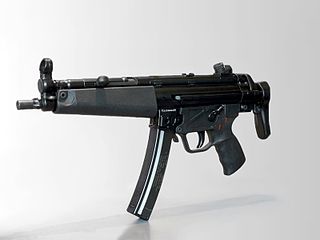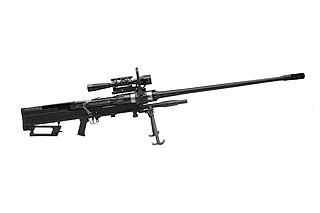
The Heckler & Koch MP5 is a submachine gun developed in the 1960s by German firearms manufacturer Heckler & Koch. It uses a similar modular design to the Heckler & Koch G3, and has over 100 variants and clones, including selective fire, semi-automatic, suppressed, compact, pistol-classed, and even marksman variants. The MP5 is one of the most widely used submachine guns in the world, having been adopted by over forty nations and numerous militaries, police forces, intelligence agencies, security organizations, paramilitaries, and non-state actors.

The IMI Galil is a family of Israeli-made automatic rifles chambered for the 5.56×45mm NATO and 7.62×51mm NATO cartridges. Originally designed by Yisrael Galili and Yakov Lior in the late 1960s, the Galil was first produced by the state-owned Israel Military Industries and is now exported by the privatized Israel Weapon Industries.

The Lee–Enfield is a bolt-action, magazine-fed repeating rifle that served as the main firearm of the military forces of the British Empire and Commonwealth during the first half of the 20th century, and was the standard service rifle of the British Armed Forces from its official adoption in 1895 until 1957.

The M1 carbine is a lightweight semi-automatic carbine that was issued to the U.S. military during World War II, the Korean War, and the Vietnam War. The M1 carbine was produced in several variants and was widely used by paramilitary and police forces around the world after World War II.
The Colt Canada C7 and C8 are a Canadian family of service rifles, manufactured by Colt Canada, having similar design and function to the Colt M16A3.

Personal defense weapons (PDWs) are a class of compact, magazine-fed, submachine gun-like automatic firearms designed to fire rifle-like cartridges. Most PDWs fire a small-caliber, high-velocity centerfire bottleneck cartridge resembling a scaled-down intermediate cartridge, essentially making them an "in-between" hybrid between a submachine gun and a carbine.
The INSAS, or Indian Small Arms System, is a family of infantry arms consisting of an assault rifle and a light machine gun (LMG). These weapons were developed in India by the Armament Research and Development Establishment and manufactured by the Ordnance Factories Board at its various factories. It was the standard infantry weapon of the Indian Armed Forces for almost three decades.
The Rifle 7.62mm 2A/2A1 is a 7.62×51mm NATO calibre bolt-action rifle adopted as a reserve arm by the Indian Armed Forces in 1963. The rifle is a variant of the Lee–Enfield rifle. The design of the rifle – initially the Rifle 7.62mm 2A – began at the Rifle Factory Ishapore of the Ordnance Factories Board in India, soon after the Sino-Indian War of 1962.
In India, the Armament Research & Development Establishment (ARDE) is a laboratory of the Defence Research and Development Organisation (DRDO). Located in Pune, it is the main DRDO lab involved in the development of conventional armaments.

Vidhwansak is an Indian multi-caliber anti-materiel rifle (AMR) or large-caliber sniper rifle manufactured by Ordnance Factory Tiruchirappalli. It can be used in the anti-materiel role for destroying enemy bunkers, lightly armoured vehicles, radar systems, communication equipment, parked aircraft, fuel storage facilities, etc. It is also effective in long-range sniping, counter sniping, and ordnance disposal roles.
F-INSAS is India's programme to equip its infantry with state-of-the-art equipment, F-INSAS standing for Future Infantry Soldier As a System. However the Indian Army has decided to drop the F-INSAS program in favour of two separate projects. The new program will have two components: one to arm the future infantry soldier with the best available assault rifle, carbines and personal equipment, such as helmets and bulletproof vests. The second component is the Battlefield Management Systems (BMS).

The Adaptive Combat Rifle (ACR) is a modular assault rifle formerly designed by Magpul Industries of Austin, Texas, and known initially as the Masada.
The 5.56×30mm MINSAS is a firearm cartridge manufactured by India's Ordnance Factory Board (OFB) for close-quarters combat use. It has an effective range of 300 metres (980 ft) and good penetration against body armor. OFB claims it exhibits penetration superior to 9mm.

The Joint Venture Protective Carbine (JVPC), also known as Modern Sub Machine Carbine (MSMC) until 2014, is a gas-operated, magazine-fed, select fire carbine designed to chamber the 5.56×30mm MINSAS cartridge. It was designed by the Armament Research and Development Establishment of the Defence Research and Development Organisation, and manufactured by Advanced Weapons and Equipment India Limited and by Kalyani Strategic Systems Limited. It was intended as a replacement for the 9mm Sterling submachine gun in service with the Indian Armed Forces.

The Colt CM901 is a modular selective-fire rifle. Its caliber and barrel length can be changed without the use of tools. Its semi-automatic variant is the LE901-16S.

The L1A1 Self-Loading Rifle (SLR), also known by the initial Canadian designation C1, or in the U.S. as the "inch pattern" FAL, is a British version of the Belgian FN FAL battle rifle. The L1A1 was produced under licence and adopted by the armed forces of the United Kingdom, Australia, Canada, India, Jamaica, Malaysia, New Zealand, Rhodesia and Singapore.

Ordnance Factory Tiruchirappalli (OFT), also called Ordnance Factory Trichy, is a small arms factory operated by Advanced Weapons and Equipment India Limited based in Tiruchirappalli, Tamil Nadu, which was previously part of Ordnance Factory Board of the Ministry of Defence, Government of India. The company is headed only by an IOFS officer called General Manager (ex officio Additional Secretary to Government of India) who is the chief executive officer, responsible for the overall management of the company.
The 40 mm Under Barrel Grenade Launcher, is a single shot grenade launcher developed by ARDE and Ordnance Factory Tiruchirappalli for use with the INSAS and AK-47 rifles used by the Indian Army. Stand alone versions of the grenade launcher exist.

The Excalibur is an assault rifle derived from the INSAS rifle, the standard rifle of the Indian Armed Forces and, to a lesser extent, the Indian Police Service. The Excalibur has many improvements over the INSAS rifle and was slated to replace it as the Indian Army's standard assault rifle; however, the Indian Army put the replacement out to tender in September 2016. Many police forces in India have procured the Excalibur in limited numbers.

The Asmi is an Indian prototype submachine gun. It was designed and developed in 2020 by the Defence Research and Development Organisation, but has not been put into service.














